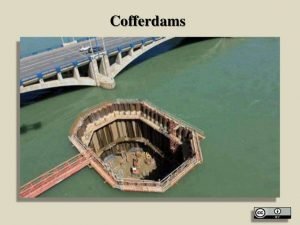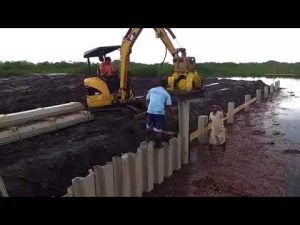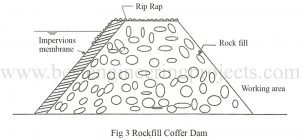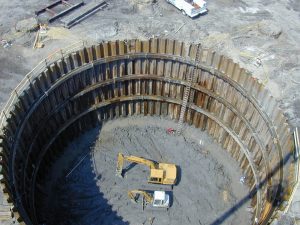Cofferdam its 6 Types and construction sequence
A cofferdam, also known as a coffer, is a wall built within and in pairs across a body of water to allow the enclosed area to be pumped out of water in the cofferdam. Enclosed coffers are commonly used to repair permanent dams or construction, bridge piers, oil platforms, etc., built over water or within.

Types of Cofferdams;
- Cantilever Sheet Pile
- Earth Embankment
- Rockfill
- Double Wall
- Cellular
- Braced
Cantilever Sheet Piles
Cantilever sheet pile cofferdam is susceptible to leakage and flood damage, making cantilever sheet pile damming better suited for smaller depths of water, up to 18 feet. Cantilever sheet piles can be constructed of concrete, wood, and steel, each with its own size limitations in what they can handle. For example, wooden sheet pile is suitable for 9 feet below, and the steel sheet pile is suitable for up to 15 feet to 18 feet head of water and similar to concrete suitable up to 18 feet head of water. Which is suitable when the headroom of water is limited. Cantilever sheet piles are bored and cast in place and used to avoid vibration and noise.

Earth Embankment
The Earth embankment of the this dam is suitable for high water heads and low velocity of water flow. The water collected is pumped exit of the excavation afterwards. A free board is provided with a minimum of 2 to 3 feet in the barrier to prevent over topping by waves. The Earth embankment of dam requires a very large base area and is adopted when excavation is very large. Clay soil is good for construction in the dry season. However, if constructed of the cofferdam in the wet season, the sand fill is the best material.
Rock-fill Embankment
The rock-fill barrier is made of rock-fill. A typical section rock-fill under the dam is better than the earth fill. Rock fills embankment is very porous and is usually provided with an impermeable soil membrane to reduce seepage. The upper part of the crest and the impermeable membrane are provided with a rap to protect against the water wave action.

Double-Wall sheet piles
Double-wall sheet piles of the this type of dam are suitable when it is required to exclude water over 36 feet up. The double-wall sheet pile consists of two straight and parallel vertical walls of sheet piling tied to each other. This type of cofferdam higher than 7.5 feet should be strutted. Sometimes an inside berm is constructed.
Cellular
The cellular dam is constructed by driving sheet piles of special shapes to form a series of bonds. The bonds are interconnected to form a watertight wall. Cellular cofferdams are filled with soils and, as a result, provide stability against the lateral forces.
There are two types of cellular cofferdams.
- Circular type and
- Diaphragm type.

COFFERDAM CONSTRUCTION SEQUENCE:
For a typical cofferdam construction, such as for pier a bridge, the construction procedure generally use is:
- Pre-dredge to remove soft sediments or soil and level the surface of the cofferdam.
- Drive temporary support piles for the template.
- The Temporarily vertical bracing frame on the support piles for the template.
- Install steel sheet piles, meeting at the centre of each side, and starting at all four corners.
- Drive sheet piles to graded.
- Drive piles within the dam if required.
- Place rockfill as a support course and a levelling.
- Place a tremie concrete sealed.
Cofferdam shapes
A cofferdam can, in essence, be constructed in any shape. However, for practical reasons and practical most these dams are either circular or rectangular. In general circular dams offer the advantage of providing a more open excavation over the entire plan area when bracing is provided solely by ring beams. However, the installation of sheet piles in circular cofferdams needs very stricter construction controls. On the other hand, rectangular shapes are simpler to construct but typically require more difficult internal bracing.
We Love Cricket